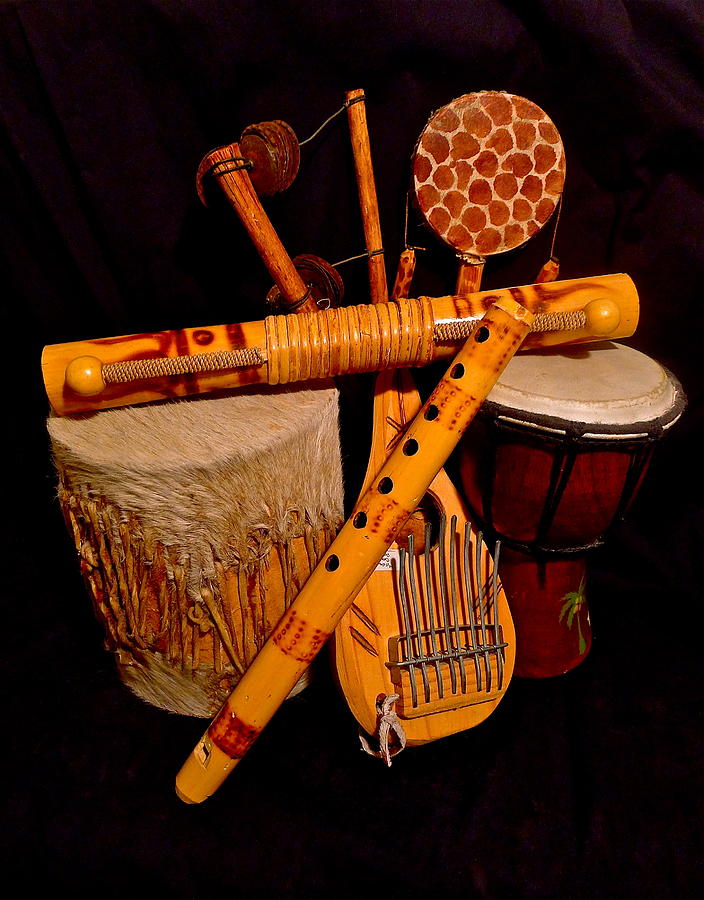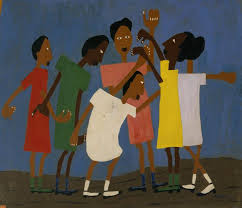
In my previous edition of the Caregiver Blog, we discussed how social art experiences can do wonders for one’s brain. A great example of a social art experience is a monthly Smithsonian “See Me” art event. The “See Me” events provide a fun, cultural, and educational experience for people with dementia and their caregivers. The “See Me” events have been a huge success judging by the number of returning pairs and the reactions to the event I witnessed at the Smithsonian National Museum of African Art called, “Art in Motion.”
 After her introduction, docent Paula explained to the group that, “In African traditional society, everybody moves - no matter their age.” She then led the group into the adjoining gallery space where Wall, a teaching artist for the aging, was waiting with an assortment of African percussion instruments. Djembes, congas, shakers, and rattles created a cacophony of noise as the participants experimented. That’s when the magic began to occur.
After her introduction, docent Paula explained to the group that, “In African traditional society, everybody moves - no matter their age.” She then led the group into the adjoining gallery space where Wall, a teaching artist for the aging, was waiting with an assortment of African percussion instruments. Djembes, congas, shakers, and rattles created a cacophony of noise as the participants experimented. That’s when the magic began to occur.
One woman, Hailley, who had worn a deadpan expression throughout the entire introduction, began smiling and laughing once she received her instrument! She was vigorously shaking her rattle and started to move her feet to the soulful, lively beat of Wall’s drum. After a few measures of the drumming’s melodic thunder, she sauntered into the center of the circle and had clearly internalized the beat. Her shoulders were enthusiastically shaking off the struggles of living with dementia. Her caregiver, Lindsay, got up and joined her companion in the center of the circle where she, too, started to dance and laugh with Paula.
Soon enough, other couples had joined the party in the center of the circle, moved by the driving rhythms of the drums. The jubilation was so contagious that a woman, assisted by her caregiver, got out of her wheelchair to partake in the dancing! When the drumming ceased, everyone returned to their seats panting heavily, but with wide grins plastered on their faces.
 One of the coordinators of the event, Ms. Amy Castine, surveyed the attendees after the activity. “How’s everyone feeling right now?” she asked. “If your faces were any indication and your dancing was any indication, I feel like you had an amazing time. Is that right?” Ms. Castine continued. The crowd responded with a round of applause and a chorus of affirmatives. Ms. Castine then proceeded to ask the guests if they were, based upon today’s activity, willing to try an outside African dance class. Hailley who, only an hour ago sat quietly with tight lips, eagerly responded with an, “I’d try!”.
One of the coordinators of the event, Ms. Amy Castine, surveyed the attendees after the activity. “How’s everyone feeling right now?” she asked. “If your faces were any indication and your dancing was any indication, I feel like you had an amazing time. Is that right?” Ms. Castine continued. The crowd responded with a round of applause and a chorus of affirmatives. Ms. Castine then proceeded to ask the guests if they were, based upon today’s activity, willing to try an outside African dance class. Hailley who, only an hour ago sat quietly with tight lips, eagerly responded with an, “I’d try!”.
“Would you say that this experience has been therapeutic for you?” Ms. Castine asked.
“At a certain point in people’s lives,” one participant began, “the past and the future don’t have a complete meaning...the here and now is what matters most. So often we think of therapy as something that affects you..” he trailed off and Ms. Castine finished his thought.
“[As something that] has a future impact?” she suggested.
“Mhm,” he continued, “and what matters is...that what we do now...is meaningful. This was great.”
"Even if you don’t necessarily remember it,” another participant, Diana, chimed in, “the experience stays with you and I think that changes you. It’s such a positive experience that it leaves such a positive lasting impression on you and it outweighs any negative experience.”
These reactions are amazing, but not surprising. A study published in Oxford Academic’s Annals of Behavioral Medicine concluded that African dance reduced stress and stopped a negative flow of emotions (a phenomenon known as negative affect) that, if left unchecked, can lead to higher rates of early mortality and lower quality of life.
In fact, the laughter and smiles are indications that the group was experiencing positive affect. Drs. Cohen and Pressman of Carnegie Mellon explain that positive affect is “behavioral evidence of the body and mind’s pleasant response to the environment.” According to the same Oxford document, positive affect and cortisol are positively correlated in dance. Cortisol is, in this case, a good stress signal (hormone) brought about by behaviorally salient events- yes, that same word is making a repeat appearance. Dance evokes good kind of stress on body- exercise stress. Exercise releases endorphins that, according to an NCBI article, puts you in an “exercise-induced euphoria.”
If dance isn’t for you, the Smithsonian has many more “See Me” events lined up for the future. Events like these work wonders for the social, mental, and emotional health of both caregivers and those they care for.
Soon enough, other couples had joined the party in the center of the circle, moved by the driving rhythms of the drums. The jubilation was so contagious that a woman, assisted by her caregiver, got out of her wheelchair to partake in the dancing! When the drumming ceased, everyone returned to their seats panting heavily, but with wide grins plastered on their faces.
“Would you say that this experience has been therapeutic for you?” Ms. Castine asked.
“At a certain point in people’s lives,” one participant began, “the past and the future don’t have a complete meaning...the here and now is what matters most. So often we think of therapy as something that affects you..” he trailed off and Ms. Castine finished his thought.
“[As something that] has a future impact?” she suggested.
“Mhm,” he continued, “and what matters is...that what we do now...is meaningful. This was great.”
"Even if you don’t necessarily remember it,” another participant, Diana, chimed in, “the experience stays with you and I think that changes you. It’s such a positive experience that it leaves such a positive lasting impression on you and it outweighs any negative experience.”
These reactions are amazing, but not surprising. A study published in Oxford Academic’s Annals of Behavioral Medicine concluded that African dance reduced stress and stopped a negative flow of emotions (a phenomenon known as negative affect) that, if left unchecked, can lead to higher rates of early mortality and lower quality of life.
In fact, the laughter and smiles are indications that the group was experiencing positive affect. Drs. Cohen and Pressman of Carnegie Mellon explain that positive affect is “behavioral evidence of the body and mind’s pleasant response to the environment.” According to the same Oxford document, positive affect and cortisol are positively correlated in dance. Cortisol is, in this case, a good stress signal (hormone) brought about by behaviorally salient events- yes, that same word is making a repeat appearance. Dance evokes good kind of stress on body- exercise stress. Exercise releases endorphins that, according to an NCBI article, puts you in an “exercise-induced euphoria.”
If dance isn’t for you, the Smithsonian has many more “See Me” events lined up for the future. Events like these work wonders for the social, mental, and emotional health of both caregivers and those they care for.
